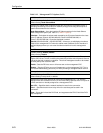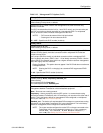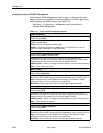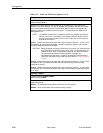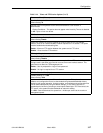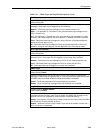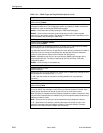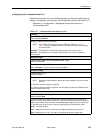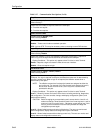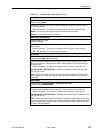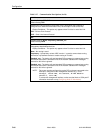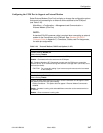
Configuration
3-60
9124-A2-LB20-00
March 2000
Table 3-16. SNMP Traps and Trap Dial-Out Options (2 of 4)
Initial Route Destination
Possible Settings: AutoRoute, COM, PVCname
Default Setting: AutoRoute
Specifies the initial route used to reach the specified Trap Manager. When proprietary
RIP is active, only one unit in the network needs to specify an interface or management
link as the initial destination. All other units can use the default setting.
Display Conditions – This option appears for each trap manager specified in the
Number of Trap Managers configuration option.
AutoRoute – Uses proprietary RIP from other FrameSaver devices to learn the route
for sending traps to the specified Trap Manager, or the Default IP Destination when no
route is available in the routing table (see Table 3-11, Node IP Options).
COM – Uses the COM port. This selection is only available when Port Use is set to
Net Link (see Table 3-17, Communication Port Options).
PVCname – Uses the defined management linkname (the name given the Management
PVC). This selection only appears when at least one Management PVC is defined for
the node.
General Traps
Possible Settings: Disable, Warm, AuthFail, Both
Default Setting: Both
Determines whether SNMP trap messages for warmStart and/or authenticationFailure
events are sent to the currently configured trap manager(s).
Disable – Does not send trap messages for these events.
Warm – Sends trap messages for warmStart events only.
AuthFail – Sends trap messages for authenticationFailure events only.
Both – Sends trap messages for both warmStart and authenticationFailure events.
Enterprise Specific Traps
Possible Settings: Enable, Disable
Default Setting: Disable
Determines whether trap messages for enterpriseSpecific events are sent to the
currently configured trap manager(s).
Enable – Sends trap messages for enterpriseSpecific events.
Disable – Does not send trap messages for enterpriseSpecific events.
Link Traps
Possible Settings: Disable, Up, Down, Both
Default Setting: Both
Determines whether SNMP linkDown or linkUp traps are sent to the currently configured
trap manager(s). A linkDown trap indicates that the unit recognizes a failure in one of
the interfaces. A linkUp trap indicates that the unit recognizes that one of its interfaces
is active.
Use the Link Traps Interface and the DLCI Traps on Interface configuration options to
specify which interface will monitor linkUp and linkDown traps messages.
Disable – Does not send linkDown or linkUp trap messages.
Up – Sends trap messages for linkUp events only.
Down – Sends trap messages for linkDown events only.
Both – Sends trap messages for linkUp and linkDown events.



